LisbonLisboaPortugal.com
The best independent guide to Lisbon
LisbonLisboaPortugal.com
The best independent guide to Lisbon
Padrão dos Descobrimentos; the Monument of the Discoveries, Lisbon
Poised on the edge of the Tejo estuary like the prow of a great ship, the Padrão dos Descobrimentos is a dramatic tribute to Portugal’s 15th-century Age of Discovery, an era when its pioneering seafarers established the nation as a dominant maritime power.
The monument depicts a stylised caravel, with a procession of influential explorers, cartographers, and patrons frozen in stone as they surge forward. Leading them all, gazing towards the Atlantic, is the visionary Prince Henry the Navigator.
Standing 52 metres tall, the monument that dominates the Belém shoreline today is a permanent recreation of an earlier, more fragile version built for the 1940 World Fair. The current limestone and steel structure was inaugurated in 1960 to commemorate the 500th anniversary of Prince Henry’s death.
For visitors, the highlight is a viewing platform at the summit, which offers some of the finest panoramic views of the Belem district. From here, you are rewarded with one of the finest perspectives of Belém, looking down upon the magnificent Jerónimos Monastery, the mouth of the estuary, and a giant marble wind rose inlaid on the plaza below.
Related articles: A guide to the district
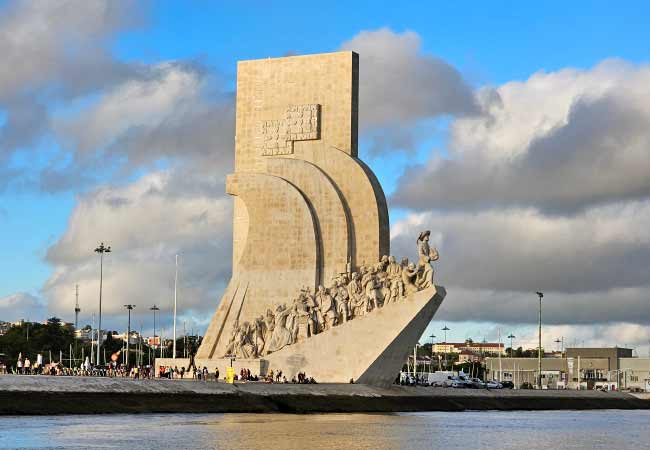
The Padrão dos Descobrimentos as seen from the Tejo Estuary
Padrão dos Descobrimentos tourist information
The Padrão dos Descobrimentos is located on the Belém waterfront, at GPS: 38.6936, -9.205 (link to Google Maps).
Upon arrival, you'll find there are three main aspects to the monument: its magnificent exterior, the temporary exhibition rooms inside, and the viewing platform at the top. While admiring the impressive sculpture from the plaza is a highlight in itself, the viewpoint offers one of the best panoramic perspectives of the entire Belém district and the Tejo estuary.
The monument's opening hours are seasonal. During the summer months from March to September, it is open from 10am to 7pm, while in the winter, from October to February, it closes an hour earlier at 6pm. It's worth noting that the last admission is always 30 minutes before the closing time. During the winter season, the monument is also closed on Mondays.
Admission for the full experience, which includes the viewing platform and the exhibition, is €10 for adults. A reduced price of €5 is available for seniors over 65 and young people aged 13 to 25, while children under 12 can enter for free. A separate, lower-priced ticket is also available if you only wish to visit the exhibition rooms. A complete visit typically takes around 40 minutes, which allows for about 15 minutes at the viewpoint and 25 minutes to explore the exhibition.
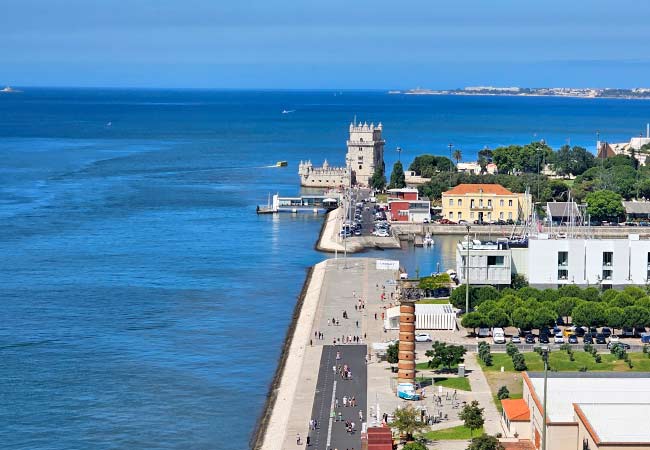
The view westwards looking towards the Torre de Belem from the top of the Padrão dos Descobrimentos
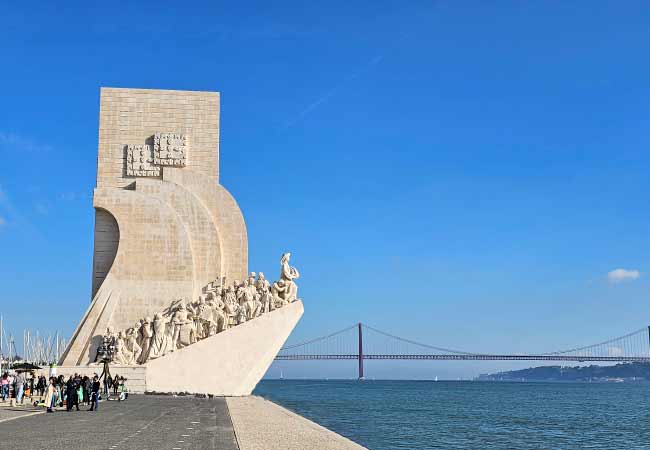
The bold shape of the Padrão dos Descobrimentos might seem out of place in historic Belém, but the monument is actually constructed from the same limestone used to build the Torre de Belém and the Mosteiro dos Jerónimos.
The Hidden Symbolism of the Discoveries Monument
While its grand scale can at first seem imposing, the Padrão dos Descobrimentos is rich with intricate symbolism and clever artistic details that tell a deeper story of the Age of Discovery.
Viewed from the waterfront, its primary form becomes clear: the soaring prow of a caravel, the revolutionary vessel of 15th-century exploration. This shape is mirrored in miniature by the very ship that the monument's leading figure, Prince Henry the Navigator, holds in his hands. The sweeping arches along the monument's sides are not merely decorative; they are stylised sails, billowing with the same ambition as the model Henry clutches.
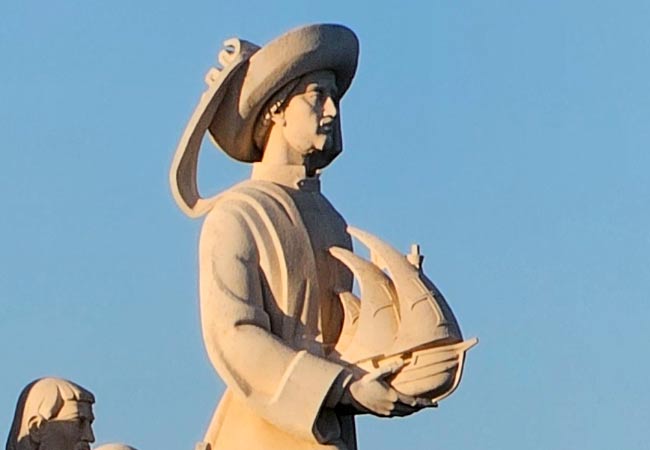
Henry is holding a caravel ship
The monument’s character shifts dramatically when seen from the rear. From a distance, looking from the direction of the Jerónimos Monastery, its profile forms a tall Latin cross. As you draw closer, however, a second image resolves itself within that shape: a massive, downward-pointing sword. This powerful duality represents the inseparable link between faith and force, where the sword was the instrument used to spread the influence of the cross across new continents.
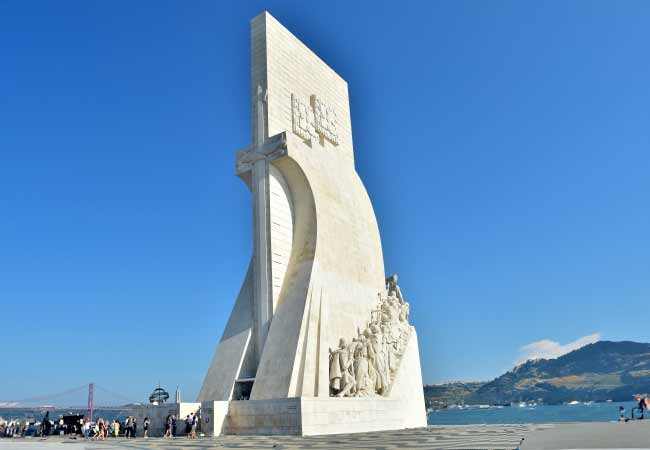
The rear of the Padrão dos Descobrimentos with the icon on the sword extending for much of its length
The individual figures along the sides also reveal important narratives. On the western face, Pêro da Covilhã holds the flag of the Order of Christ, the Portuguese successor to the Knights Templar. This is a direct acknowledgement of the powerful and influential religious order, based in the town of Tomar, which is believed to have financed many of Prince Henry's earliest voyages
On the opposite side, explorers Bartolomeu Dias and Diogo Cão are depicted heaving a ‘Padrão’ into place. These heavy stone pillars, inscribed with the Portuguese coat of arms, were planted on newly discovered shores to officially claim the land for the crown. The sculpture recalls specific historic moments, such as Diogo Cão planting a Padrão at Cape Cross (Angola) in 1486, and Bartolomeu Dias leaving another near the southern tip of Africa in 1488.
Finally, a subtle detail connects the monument to its historic neighbours. All of the statues are carved from Lioz limestone, the same prized material used for both the Jerónimos Monastery and the Torre de Belém. Sourced from the hills of Sintra, this shared stone physically and symbolically unites the great monuments of Portugal's golden age.
Who are all the figures in the Padrão dos Descobrimentos?
The eastern side of the Padrao dos Descobrimentos portrays the seafaring explorers of the ‘Age of Discovery’. As you view this side of the monument, you are facing westward down the Tejo Estuary towards the open sea, just as these explorers once did when they departed from Lisbon.
Interesting features include King Afonso V (2) kneeling, representing the Portuguese monarchy's support of the highly expensive expeditions. Vasco da Gama (3), who discovered the sea route to India, stands behind the king. Ferdinand Magellan (5) is also commemorated here, as although he circumnavigated the globe under Spanish patronage, he was Portuguese. Bartolomeu Dias (11) and Diogo Cão (12) are shown moving a Padrão.
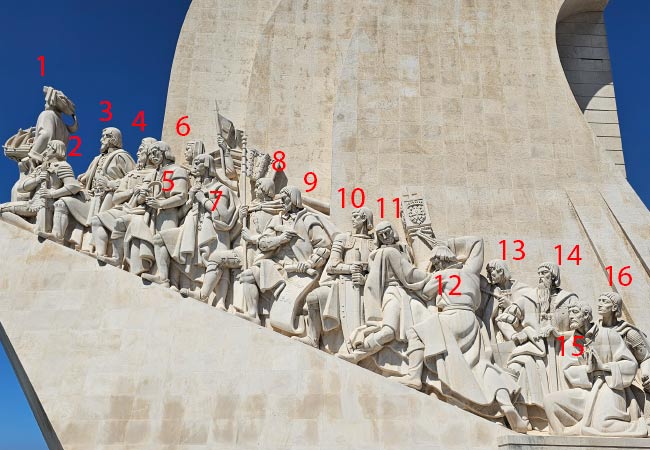
Key: 1) Infante D. Henrique (Henry the Navigator) 2) Afonso V of Portugal (King of Portugal) 3) Vasco da Gama (discovered the sea route to India) 4) Pedro Álvares Cabral (discovered Brazil) 5) Ferdinand Magellan (first to circumnavigate the globe) 6) Nicolau Coelho (navigator) 7) Gaspar Corte Real (discovered Greenland and Newfoundland) 8) Martim Afonso de Sousa (navigator) 9) João de Barros (chronicler) 10) Estêvão da Gama (captain) 11) Bartolomeu Dias (discovered the Cape of Good Hope) 12) Diogo Cão (first to reach the Congo River) 13) António de Abreu (navigator) 14) Afonso de Albuquerque (second Viceroy of India) 15) Saint Francis Xavier (missionary saint) 16) Cristóvão da Gama (captain)
The western side depicts the financiers and supporters of the ‘Age of Discovery’. When viewing this side of the monument, you are looking down the Tejo Estuary towards Lisbon, signifying that these figures were not explorers. Notable features include Pêro da Covilhã (9) holding a Templar flag, reflecting his connections with the Order of Christ, as well as poet Luís de Camões (12) with his manuscripts. Philippa of Lancaster (16) is the only female on the monument and was the mother of Henry the Navigator.
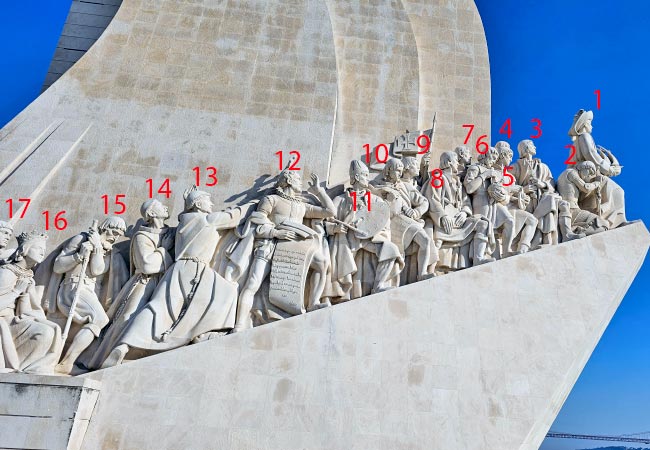
Key: 1) Infante D. Henrique (Henry the Navigator) 2) Fernando (son of King João I) 3) João Gonçalves Zarco (navigator) 4) Pêro de Alenquer (naval-pilot) 5) Gil Eanes (navigator) 6) Pedro Nunes (mathematician) 7) Pêro Escobar (naval-pilot) 8) Jácome de Mallorca (cartographer) 9) Pêro da Covilhã (explorer) 10) Gomes Eanes de Zurara (chronicler) 11) Nuno Gonçalves (painter) 12) Luís de Camões (Poet) 13) Henry of Coimbra (Franciscan missionary) 14) Gonçalo de Carvalho (Dominican missionary) 15) Fernão Mendes Pinto (explorer) 16) Filipa de Lencastre (Queen of Portugal) 17) Infante Pedro (son of King João I of Portugal)
Prince Henry: The Navigator Who Never Sailed
Infante Dom Henrique (1394-1460), known to the world as Henry the Navigator, is the undisputed central figure of the Padrão dos Descobrimentos. He stands at its prow, supported by the historical figures lining both sides of the monument.
Ironically, the man immortalised as 'the Navigator' never led a seafaring expedition, was neither a sailor nor a cartographer, and only ever crossed the sea on a short voyage to Morocco. His famous title is a much later invention, popularised by German and British historians in the 19th century.
Henry’s true historical importance lies not in his own voyages, but in his role as the chief patron and strategist of Portuguese exploration. From his court in the Algarve region at the south-western tip of Europe, he financed and orchestrated the early expeditions that charted the West African coastline, laying the groundwork for the empire to come. He was the visionary organiser, not the hands-on explorer.
It is important to view this era through a clear lens. While Portuguese culture rightfully romanticises the courage of the explorers who sailed these tiny ships into the unknown, their voyages were accompanied by brutal conquest. In just a decade (1501-1511), the Portuguese violently dismantled the established Arabic sea trade in the Indian Ocean and subjugated kingdoms from Mozambique to Kerala. The bravery of the navigators was inseparable from the power of the Portuguese cannon, which became the instrument of a new and violent global order.
The Rosa dos Ventos world map mosaic
In front of the Padrão dos Descobrimentos is a beautiful 50-metre-wide mosaic depicting a rose compass, with a central map illustrating all the countries Portugal sailed to during the 16th century. This intricate artwork, known as the Rosa dos Ventos, was installed in 1960 as a gift from South Africa in commemoration of the 500th anniversary of Henry the Navigator's death on November 13, 1460.

The Rosa dos Ventos as seen from the top of the Padrão dos Descobrimentos
History of the Padrão dos Descobrimentos
The Padrao dos Descobrimentos was originally built as a temporary centrepiece for the World Fair of 1940 that was hosted by Lisbon. This event was intended to increase trade during the harsh years of depression and for Portugal to enhance its position of neutrality amid the growing tensions in the world. The original monument was constructed from wood and plaster, with the intention of it being dismantled after the fair.
During the later stages of the Estado Novo dictatorship, there was a trend for romantic idealisation of Portuguese history and the Discoveries Monument was converted to a permanent feature.
The re-fabrication was completed in 1960 to coincide with the 500th anniversary of Henry the Navigator's death, and this celebration was embraced by the patriotic Estado Novo dictatorship. The figure of Henry the Navigator stands at the front of the monument, gazing out towards the Atlantic Ocean.
Why were each of the figures import to the Portuguese age of discovery?

1) Infante D. Henrique, commonly known as Henry the Navigator, was a pivotal figure in the early days of the Portuguese Age of Discovery. He sponsored numerous expeditions along the African coast, leading to significant discoveries and the establishment of a sea route to India.
2) Infante Fernando, also known as Fernando the Saint Prince, was a younger son of King João I. Despite being less known for exploration, he played a crucial role in the Portuguese campaigns in North Africa and was captured during the Siege of Tangier, later dying in captivity.
3) João Gonçalves Zarco was an intrepid navigator who discovered and settled the island of Madeira. His exploration efforts significantly contributed to the Portuguese colonization of the Atlantic islands.
4) Pêro de Alenquer was a distinguished naval pilot who guided Vasco da Gama on his historic voyage to India. His navigational skills and experience were crucial in overcoming the challenges of the long sea journey.
5) Gil Eanes was a pioneering navigator who was the first to sail beyond the dreaded Cape Bojador. His successful voyage marked a significant breakthrough in Portuguese exploration, paving the way for further expeditions along the African coast.
6) Pedro Nunes was a brilliant mathematician and cosmographer whose work on navigation and cartography significantly advanced maritime exploration. His inventions and theories improved navigational techniques, making sea voyages safer and more precise.
7) Pêro Escobar was a skilled naval pilot and explorer who played a crucial role in the discovery of the Gulf of Guinea. His expertise in navigation helped expand Portuguese influence along the West African coast.
8) Jácome de Mallorca was a renowned cartographer whose maps greatly contributed to the Age of Discovery. His detailed and accurate charts helped navigators explore uncharted waters with greater confidence.
9) Pêro da Covilhã was a skilled explorer and diplomat who undertook secret missions to gather intelligence in the Middle East and India. His reports were instrumental in planning Vasco da Gama's successful sea route to India. He holds the Knights Templar flag and had close connections to the Order of Christ.
10) Gomes Eanes de Zurara was a prominent chronicler whose works provide a detailed account of the early Portuguese explorations. His chronicles, such as the ‘Chronicle of the Discovery and Conquest of Guinea’, are invaluable historical documents.
11) Nuno Gonçalves was a master painter of the Portuguese Renaissance, renowned for his detailed and expressive works. His most famous piece, the ‘Saint Vincent Panels’, captures the spirit of this era and provides a window into 15th-century Portugal.
12) Luís de Camões is Portugal's greatest poet, best known for his epic work ‘Os Lusíadas’, which celebrates Portuguese explorations. His literary genius and adventurous life, including his own travels to Asia, make him a central figure in Portuguese culture.
13) Henry of Coimbra was a Franciscan missionary known for his efforts to evangelize in North Africa. His work laid the foundations for future missions and his legacy includes fostering cultural exchanges between Europe and Africa.
14) Gonçalo de Carvalho was a dedicated Dominican missionary who worked tirelessly to spread Christianity. His missions took him to distant lands where he endeavoured to convert and educate indigenous populations.
15) Fernão Mendes Pinto was an adventurous explorer and writer whose travels took him throughout Asia. His book, ‘Peregrinação’, provides a vivid and often exaggerated account of his adventures, offering valuable insights into the 16th-century Asian world.
16) Filipa de Lencastre, an English princess who became Queen of Portugal, was the mother of Henry the Navigator. Her marriage to King João I strengthened Anglo-Portuguese ties and her pious and intellectual upbringing deeply influenced her children, especially Henry.
17) Infante Pedro, the son of King João I, was a notable prince and statesman. He played a crucial role in the administration of Portugal and was known for his extensive travels across Europe, which broadened his perspectives and influenced his governance.
Discover more of Lisbon with our most popular guides
If you've found our content valuable, we'd welcome your support.
The digital publishing landscape has evolved significantly. As a small independent publisher, we face growing challenges. Search engines increasingly favour paid content over organic results, while AI-generated content often reproduces original work without attribution.
To support our work, please consider bookmarking this page (press Ctrl + D) for quick access. If you find an article helpful, we'd be grateful if you'd share it with friends on social media.
For specific questions, please see our Reddit community at r/LisbonPortugalTravel.
Should you notice any outdated or incorrect information, please contact us at [email protected]
Thank you for helping us continue to provide valuable content in an increasingly challenging digital environment.
A complete list of all of our Lisbon articles
If you've found our content valuable, we'd welcome your support.
The digital publishing landscape has evolved significantly. As a small independent publisher, we face growing challenges. Search engines increasingly favour paid content over organic results, while AI-generated content often reproduces original work without attribution.
To support our work, please consider bookmarking this page (press Ctrl + D) for quick access. If you find an article helpful, we'd be grateful if you'd share it with friends on social media.
For specific questions, please see our Reddit community at r/LisbonPortugalTravel.
Should you notice any outdated or incorrect information, please contact us at [email protected]
Thank you for helping us continue to provide valuable content in an increasingly challenging digital environment.



































